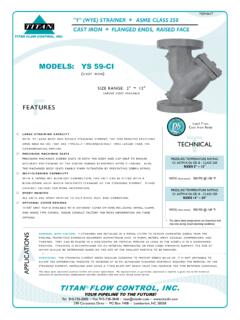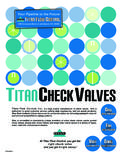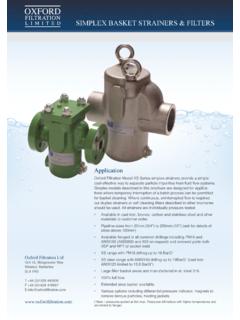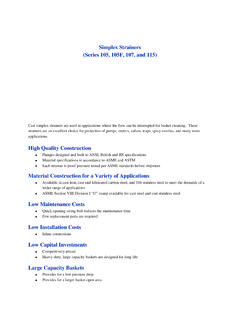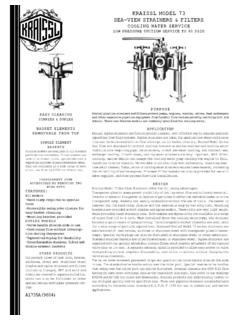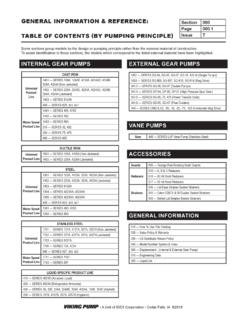Transcription of TITAN FCI SCREEN SELECTION
1 SCREEN AND basket SELECTION GUIDEC hoosing the right straining elementTITAN290 Corporate DrivePO Box 7408 Lumberton, NC 28358 TITAN Flow Control, : 910-735-0000 Fax: of the most important design considerations when purchasing a strainer is specifying the perforation or mesh size of the straining element. The straining element (commonly referred to as a SCREEN for WYE strainers and a basket for basket strainers) is a mechanical filter which removes and retains particles too large to pass through yet allows the flowing media (liquid or gas) to pass unobstructed. This process is illustrated in Figure 1. By cleaning the flowing media, the straining element helps to protect expensive downstream equipment such as pumps, meters, spray nozzles, compressors, and Opening Size:In general, SCREEN openings should be approximately one-half the diameter of the largest allowable particle.
2 The largest allowable particle is defined as the size of particle that can pass through downstream equipment without causing damage. For example, if the maximum allowable particle is 1/16 inch than the SCREEN opening would be specified at 1/32 inch. In addition to the size of particles, the quantity of debris in the flowing media must also be considered when determining the appropriate opening elements can only be used to remove insoluble floating impurities. The most common range of particle retention is 1 inch down to 40 microns (.0015 inch). See Figure 2 for a comparison of sizes for a variety of common TITAN FCI stainer should always be installed ahead of pumps and other expensive, downstream equipment to help ensure proper protection and trouble-free operation. This even holds true for "clean lines" to protect against scale and accidentally introduced items such as: tools, gaskets, nuts, or Opening Size: common mistake is to specify a SCREEN opening that is to small for the application.
3 This can lead to overstraining and should be avoided for the following reasons: Maintenance costs are significantly increased due to excessive cleaning requirements. Pressure drop is increased dramatically. The straining element may become damaged and some applications requiring finer filtrations, it may be advisable to strain in gradual steps. This is accomplished by placing progressively smaller straining elements in series. As always, a TITAN FCI engineer is available to assist you in developing a solution for any special straining requirements you may Material:Irregardless of the strainer housing material being used, the most common construction material used for straining elements is stainless steel. This is due to the inherent resistance to corrosion stainless steel provides. As such, TITAN FCI's standard construction material for all straining elements is Type 304 stainless steel.
4 Other materials (316 SS, 316L, and Monel) are available upon application. Please consult a TITAN FCI engineer for determining the best material for your application. Straining elements are not designed to withstand the same pressure as the strainer housing. If the straining element becomes fully clogged, it will be exposed to the same pressure as the housing. In most cases, this will cause the straining element to fail. For these types of applications, TITAN FCI offers special drilled or wedge wire screens that can withstand full line pressure when clogged. A convenient way to monitor the differential pressure is to install pressure gauges on both the inlet and outlet sides of the strainer. It is not recommended to allow the differential pressure to exceed 20 psi. Figure 1: Straining IllustrationTitan Flow Control - Standard SCREEN and basket DesignsTitan Flow Control - Special SCREEN and basket DesignsMagnetic SCREEN Assembly:Magnetic SCREEN assemblies are recommended for applications that require the removal and retention of microscopic ferrous particles.
5 Virtually any TITAN FCI strainer can be fitted with powerful ALNICO magnetic inserts to provide protection against both magnetic and non-magnetic particles. These magnetic inserts create a continuous magnetic field within the interior of the straining element trapping ferrous particles even the finest mesh would typical not remove. Magnetic SCREEN assemblies can effectively be employed in lubrication systems, hydraulic systems, and machine coolant Drilled or Wedge Wire Screens: TITAN FCI can also fabricate straining elements that will withstand full line pressure when clogged. These straining elements have individually drilled holes in heavy gauge metal (up to 3/8" thick) or utilize wedge (Convoluted) Straining Elements:Particle retention is directly related to the amount of surface area available on the straining element. As straining occurs, the gradual retention of particles can cause a layered build-up on the surface of the straining element.
6 With cylindrical straining elements, this accumulation pattern can quickly clog the outlet side of the strainer causing a significant increase in pressure drop. This is illustrated in Figure 8. To solve this problem, TITAN FCI can fabricate pleated straining elements which expand the straining surface area and disperse the particles in a uniform manner. This alleviates the layered build-up and typical loss in pressure drop. This is illustrated in Figure 9. Figure 8: Top View - basket Strainer - Cylindrical Straining ElementFigure 9: Top View - basket Strainer - Pleated Straining ElementTitan FCI can manufacture straining elements for all types of strainers including "Y", "T", and basket in a wide variety of materials. We can also manufacture conical/temporary strainers. Please send us your prints, samples, or simply give us your requirements and let us design a straining element for you.
7 In most cases, straining elements can be ordered by referencing TITAN FCI's or any other manufacturers' strainer model 3:STYLE 'A'Cylindrical ScreenGenerally used for "Y" Type 4:STYLE 'B'Slanted Type BasketTypically used for larger sized Simplex and Duplex basket Strainers. Slanted inlet side reduces pressure drop across the strainer. Strainer cover presses down on handle to ensure straining element remains securely 5:STYLE 'C' basket TypeTypically used for smaller sized Simplex and Duplex basket Strainers. Strainer cover presses down on handle to ensure straining element remains securely 6:STYLE 'D'Temporary ConicalOften referred to as a cone or witch's hat strainer. Used during start-up 7:STYLE 'E'Temporary ConicalOften referred to as a basket or pilgrim's hat strainer. Used during start-up ordering, please specify:1.
8 Pipe Size2. Straining Element Type3. Perforation or Mesh4. Construction Material5. Design Type (cone, basket etc.)6. Flow Direction7. Open Area % and Length8. Pressure Microns ( m)1 Perf (25,400 m)1/4 Perf (6350 m)20 Mesh (914 m)1/8 Perf (3175 m)1/16 Perf (1587 m) Perf (12,700 m)1/32 Perf (838 m)40 Mesh (381 m)100 Mesh (139 m)Large Aquatic LifeLarge Debris/BranchesSmall Aquatic Life and DebrisGravel/Crustacea/TwigsSand/Silt/Fl ocsClay/Pollen AlgaeMicro Organisms/BacteriaOil Emulsion/Clay AlgaeColloidal Solids/Virus/ProteinsSome Corrosion ProductsFigure 2: Particle Size Comparison ChartSST-0607 LENGTHDIAMETERDIAMETERPERFLENGTHLENGTHPE RFLENGTHDIAMETERLENGTHDIAMETERDIAMETERPE RFLENGTHDIAMETERDIAMETERLENGTHDIAMETERDI AMETERLENGTHDIAMETERT itan Flow Control - Perforation and Mesh ConfigurationsTable 2: Standard Mesh and Perforated Configurations (1)(2)20 Open Openings(.)
9 914 mm / 914 m).014 Wire Diameter1/32" Diameter(.033 in / mm).055 Centers28% Open Area330 holes/sq. Line30 Open Openings(.566 mm / 566 m).011 Wire Diameter3/64" Diameter(.045 in / mm).066 Centers36% Open Area225 holes/sq. Line40 Mesh36% Open Openings(.381 mm / 381 m).010 Wire Diameter1/16" Diameter(.0625 in / mm)3/32" Centers41% Open Area132 holes/sq. Line60 Open Openings(.246 mm / 246 m).007 Wire Diameter1/8" Diameter(.125 in / mm)3/16" Centers40% Open Area33 holes/sq. Line80 Mesh36% Open Openings(.190 mm / 190 m).005 Wire Diameter5/32" Diameter(.1563 in / mm)3/16" Centers63% Open Area33 holes/sq. Line100 Open Openings(.139 mm / 139 m).0045 Wire Diameter1/4" Diameter(.25 in / mm)5/16" Centers58% Open Area12 holes/sq. LineNotes:1. TITAN FCI's standard construction material for all screens and baskets is Type 304 Stainless Steel.
10 Other materials ( Type 316 and Monel) are available upon request. Please consult factory for pricing and availability for non-stock Table 2 represents TITAN FCI's most commonly stocked mesh and perforation arrangements. A large variety of special mesh and perforation options are available. Please consult the factory or your local sales representative regarding the specific requirements of your Table 3 & 4 represent optional mesh and perf configurations which are not routinely stocked but can be furnished upon request. Please consult factory for pricing and For mesh lined screens or baskets, 5/32" perf is most commonly used for outer support (backing). If other backing is required, please specify at time of 3: Optional Mesh Configurations (3)Mesh(Linear inch)WireDia.(in)Hole OpeningsOpen Area(%)(in)( m) 863.


